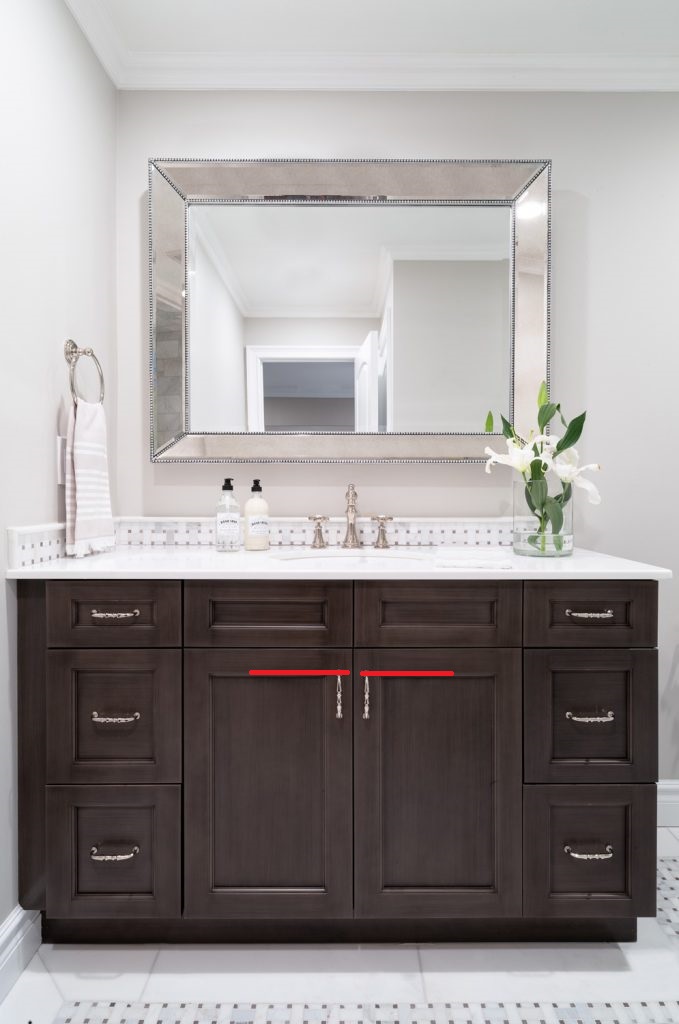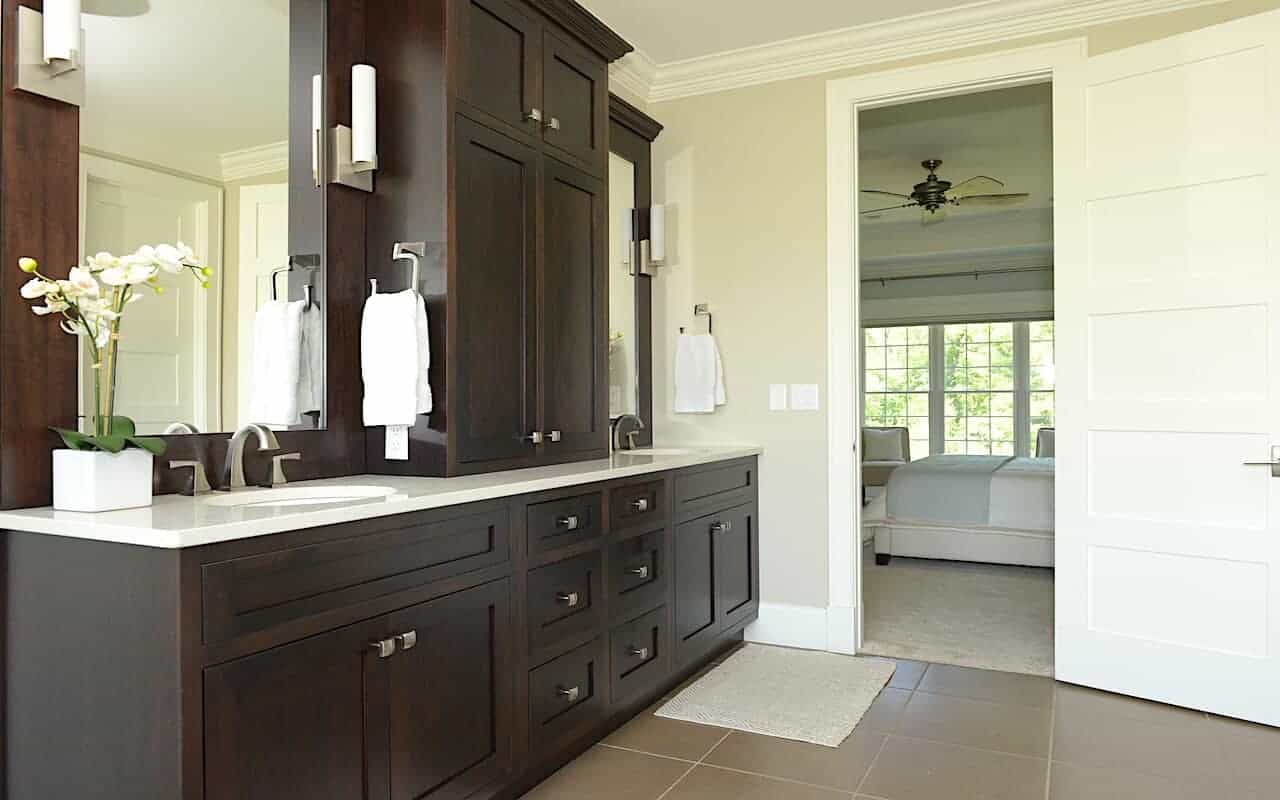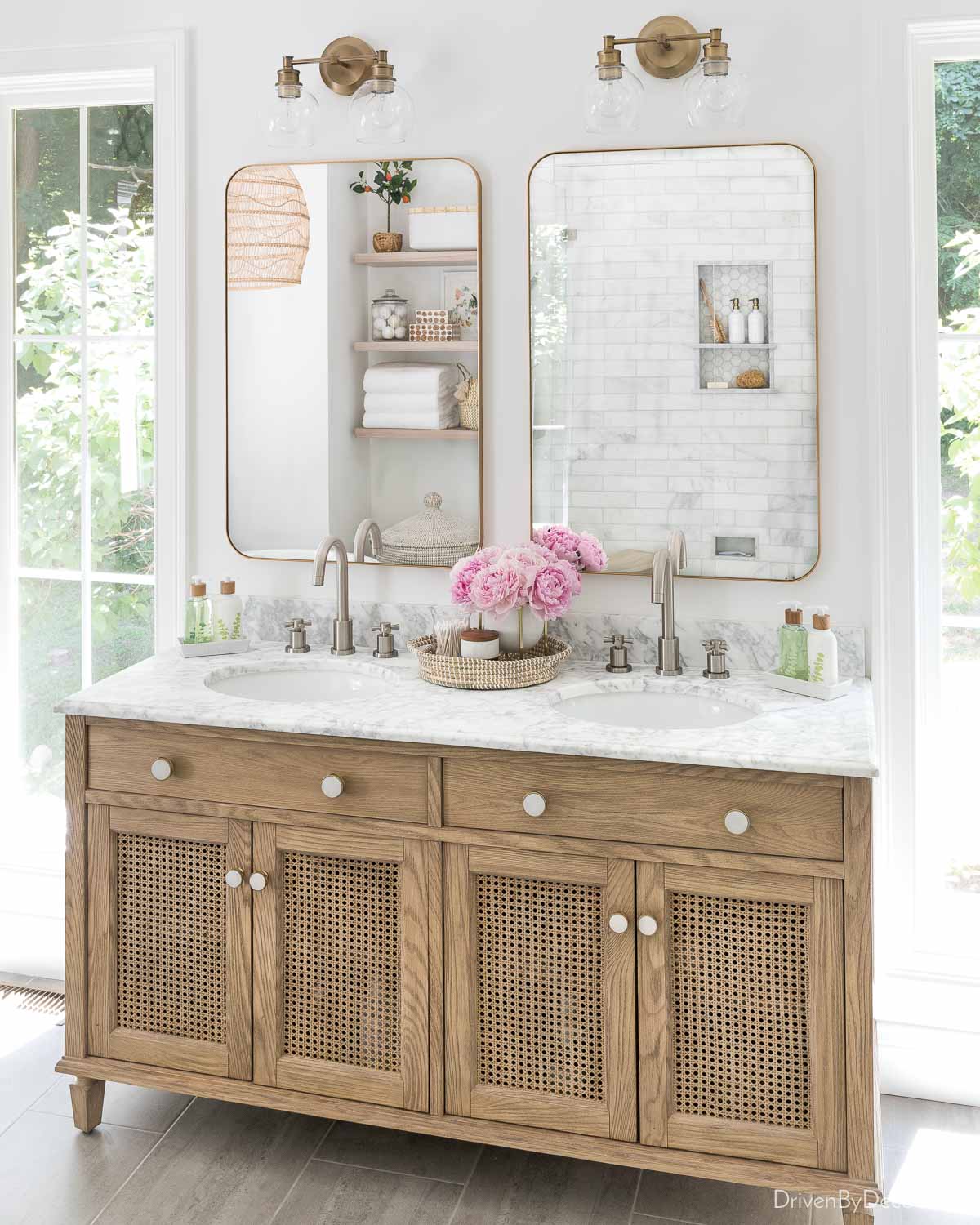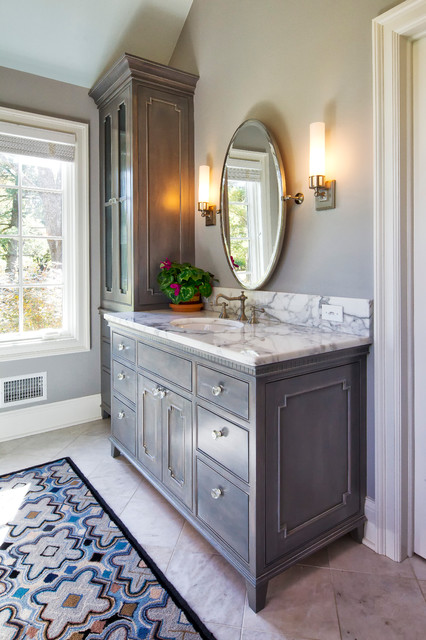Gather the Necessary Tools and Materials
Before you begin installing knobs on your bathroom cabinets, it’s essential to gather all the tools and materials you’ll need for the job. Here’s a list of what you’ll require:
- Knobs: Choose the knobs you want to install on your bathroom cabinets. Consider the style, finish, and size of the knobs to ensure they complement the overall aesthetic of your bathroom.
- Screwdriver: Depending on the type of screws included with your knobs, you may need a Phillips or flathead screwdriver to attach them to the cabinets.
- Measuring Tape: Use a measuring tape to accurately determine the placement of the knobs on your cabinets. This ensures that they are evenly spaced and aligned for a professional-looking finish.
- Pencil: Mark the positions for the knobs on your cabinets using a pencil. This will serve as a guide for drilling the holes and installing the knobs.
- Drill and Drill Bits: If your cabinets do not already have pre-drilled holes for the knobs, you’ll need a drill and appropriate drill bits to create them. Choose a drill bit size that matches the diameter of the screws included with your knobs.
- Level: Use a level to ensure that the knobs are installed straight and level on the cabinets. This helps prevent crooked or uneven placement.
- Screws: Check if the knobs come with screws for installation. If not, make sure you have screws of the appropriate size and length to securely attach the knobs to the cabinets.
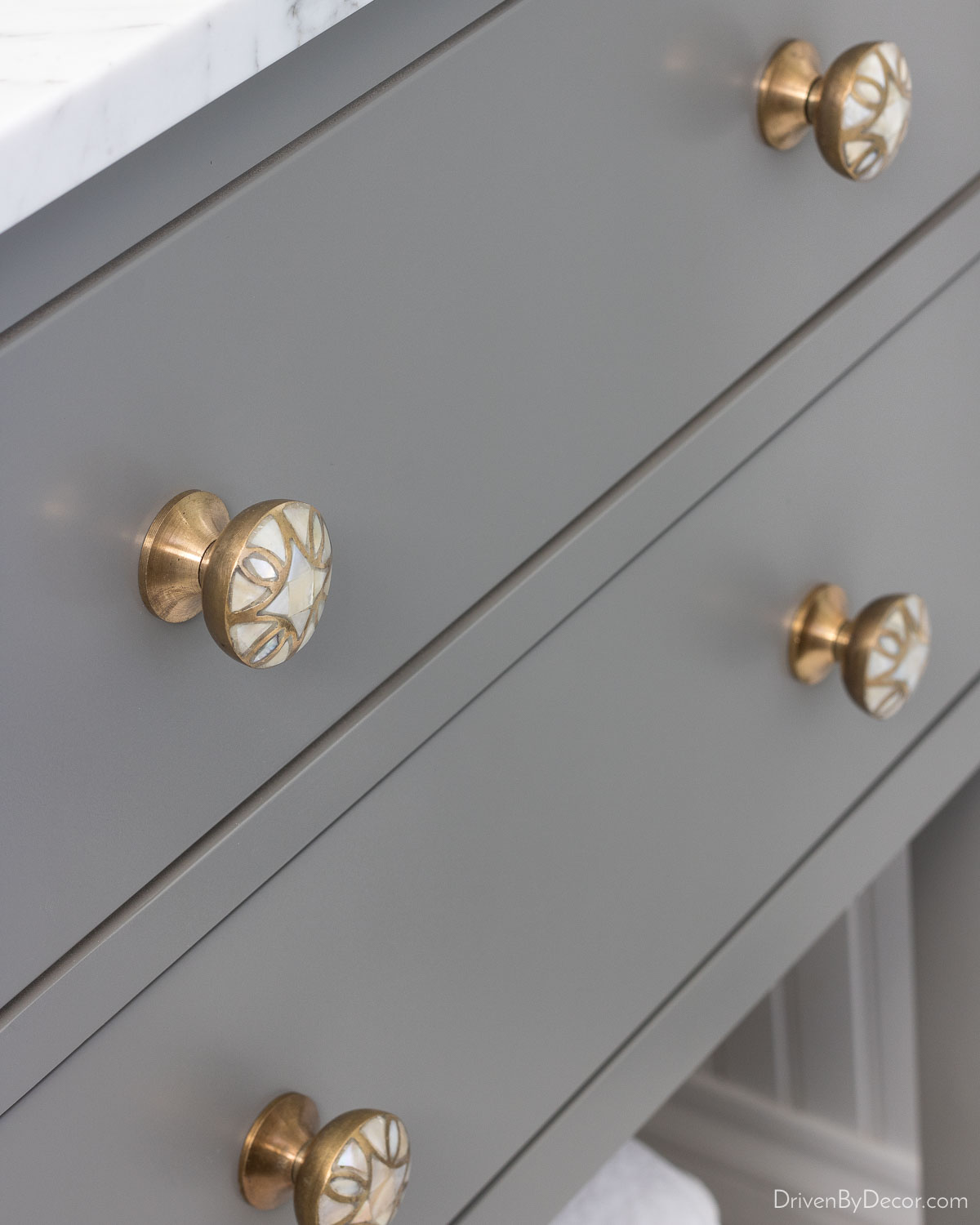
Preparing the Cabinets for Installation
Before you can install the knobs on your bathroom cabinets, you’ll need to prepare the cabinets themselves. Here’s how to do it:
Clean the Surfaces: Start by cleaning the surfaces of the cabinets where you’ll be installing the knobs. Use a mild detergent or cleaning solution and a soft cloth to remove any dirt, grease, or residue.
Measure and Mark: Use a measuring tape and pencil to mark the exact placement of the knobs on the cabinets. Measure carefully to ensure that the knobs are evenly spaced and aligned for a cohesive look.
Find the Center: To determine the center of each cabinet door or drawer front, measure the width and height and divide by two. Mark the center point with a pencil to indicate where you’ll drill the hole for the knob.
Protect the Surface: Place a small piece of masking tape over each mark to help prevent splintering or chipping when drilling the holes for the knobs. This also helps ensure a clean and professional finish.
Drill Holes: If your cabinets do not already have pre-drilled holes for the knobs, use a drill and appropriate drill bit to create them. Position the drill bit over each marked point and drill straight through the cabinet door or drawer front.
Deburr and Clean: After drilling the holes, use a deburring tool or sandpaper to smooth any rough edges or burrs around the holes. Wipe away any dust or debris with a clean cloth to ensure a clean and smooth surface for installation.
Determining Placement for the Knobs
Determining the placement of the knobs on your bathroom cabinets is crucial for achieving a cohesive and balanced look. Here are some tips to help you decide where to position the knobs:
Consider Ergonomics: Think about how you’ll be using the cabinets and where it feels most natural to reach for the knobs. For example, place knobs slightly higher on lower cabinets and slightly lower on upper cabinets for comfortable access.
Align with Hardware: If you have existing hardware or fixtures in your bathroom, such as faucets or towel bars, consider aligning the knobs with them for a cohesive look. This helps create visual harmony and balance in the space.
Create Symmetry: For a polished and cohesive look, aim for symmetry when placing the knobs on your cabinets. Ensure that the knobs are evenly spaced and aligned both horizontally and vertically for a balanced appearance.
Account for Clearance: Make sure there is enough clearance between the knobs and any adjacent cabinets, drawers, or other obstacles. This prevents the knobs from interfering with the opening and closing of the cabinets and ensures smooth operation.
Mock-Up Placement: Before drilling any holes, use painter’s tape or removable adhesive putty to temporarily attach the knobs to the cabinets and test different placement options. Step back and evaluate the placement from various angles to find the most visually pleasing arrangement.
Consider Cabinet Style: The style and design of your cabinets can also influence the placement of the knobs. For example, for modern, minimalist cabinets, you may prefer a centered or edge-mounted knob placement, while for traditional cabinets, a centered placement may be more appropriate.
Installing the Knobs on Bathroom Cabinets
Now that you’ve prepared the cabinets and determined the placement of the knobs, it’s time to install them. Here’s how to do it:
Align the Knobs: Position each knob over the drilled hole on the cabinet door or drawer front, ensuring that it is centered and aligned according to your markings.
Insert the Screws: If your knobs come with screws, insert them through the back of the cabinet door or drawer front and into the holes in the knobs. Use a screwdriver to tighten the screws securely, but be careful not to over-tighten, as this can damage the screws or strip the threads.
Check Alignment: After installing each knob, step back and check the alignment and spacing to ensure consistency and uniformity across all the cabinets. Make any necessary adjustments before moving on to the next knob.
Repeat the Process: Continue installing the knobs on all the cabinet doors and drawer fronts following the same steps. Take your time and work carefully to ensure that each knob is installed securely and aligned properly.
Test the Operation: Once all the knobs are installed, test the operation of the cabinet doors and drawers to ensure that the knobs function smoothly and without any interference. Make any final adjustments as needed to achieve optimal operation.
Clean Up: Remove any masking tape or adhesive residue from the cabinets and clean the surfaces with a mild detergent or cleaning solution to remove any dust or debris from the installation process.
Adding Finishing Touches
With the knobs installed on your bathroom cabinets, it’s time to add some finishing touches to complete the look. Here are some ideas:
Coordinate with Hardware: If you have other hardware or fixtures in your bathroom, such as faucets or towel bars, consider coordinating the finish of the knobs with them for a cohesive look. Choose knobs in a matching or complementary finish to tie the room together.
Accessorize with Backplates: Add decorative backplates behind the knobs for an extra layer of style and sophistication. Backplates can help protect the cabinet surface from scratches and wear and add visual interest to the knobs.
Personalize with Custom Knobs: For a unique and personalized touch, consider replacing standard knobs with custom or novelty knobs that reflect your personality and interests. Choose knobs in fun shapes, colors, or designs to add a playful element to the bathroom decor.
Upgrade with Crystal Knobs: Add a touch of elegance and glamour to your bathroom cabinets with crystal knobs. Crystal knobs catch the light and sparkle beautifully, adding a touch of luxury and sophistication to the space.
Mix and Match Styles: Get creative and mix and match different styles of knobs for an eclectic and personalized look. Combine knobs in various shapes, sizes, and finishes to create visual interest and add personality to your cabinets.
Accessorize with Drawer Pulls: If you have large drawers in your bathroom vanity, consider installing drawer pulls in addition to knobs for added functionality and style. Choose pulls in a coordinating style and finish to complement the knobs on the cabinet doors.
Maintenance and Troubleshooting Tips
After installing knobs on your bathroom cabinets, it’s essential to maintain them properly to ensure they continue to look and function their best. Here are some maintenance and troubleshooting tips to keep in mind:
Regular Cleaning: Clean the knobs regularly with a mild detergent or cleaning solution and a soft cloth to remove dirt, grease, and fingerprints. Avoid abrasive cleaners or harsh chemicals that can damage the finish of the knobs.
Tighten Loose Screws: Periodically check the screws that hold the knobs in place and tighten them if they become loose. Use a screwdriver to snugly tighten the screws without over-tightening, as this can strip the threads or damage the knobs.
Replace Worn or Damaged Knobs: If the knobs become worn, damaged, or outdated over time, consider replacing them with new ones to refresh the look of your bathroom cabinets. Choose knobs in a similar style and size to ensure a seamless transition.
Prevent Rust and Corrosion: If your bathroom is prone to moisture and humidity, choose knobs made from rust-resistant materials such as stainless steel or brass to prevent corrosion and discoloration over time.
Check for Interference: Occasionally check the operation of the cabinet doors and drawers to ensure that the knobs are not interfering with their opening and closing. If you notice any issues, such as sticking or binding, adjust the placement of the knobs as needed.
Address Loose or Misaligned Knobs: If a knob becomes loose or misaligned, tighten the screws or adjust the placement to correct the problem. If the hole in the cabinet door or drawer front becomes stripped, fill it with wood putty or filler material and re-drill the hole for a secure fit.
Cabinet knobs and pulls are defining pieces in a bathroom.
A Guide to Cabinet Hardware Placement – Caroline on Design
Knobs vs. Pulls – Which One Is Better?
Our Go-To Cabinet Hardware Placement + 60 Of Our Shoppable
Bathroom Cabinet Knobs: My Favorites!
Installing cabinet hardware
Vanity Hardware That Adds a Stylish Touch to the Bath
Related Posts:




